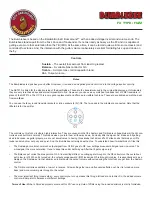
Bumblebee
The Bumblebee is based on the Baldwin-Burns® Buzzaround™ with an added voltage inverter and volume knob. The
Bumblebee stands apart from the Fuzz Face and Tonebender. It’s not as nearly as bassy as the FF and it is capable of
getting even more fuzz saturation than the TB (IMO). At the same time, it can be tamed quite well into some classic (and
controlled) fuzz tones. And, the interaction with the guitar volume is absolutely excellent for dialing fuzz up and down on
the fly.
Controls
Sustain
– The overall fuzz amount from least to greatest.
Balance
– A variable bias control for Q3.
Timbre
– A simple tone control/capacitor blend.
Vol
- Output volume.
Notes
The BumbleBee is a positive ground effect. However, it is wired as a negative ground circuit due to the voltage inverter circuitry.
The NKT213 is listed for the stock version of the BumbleBee. These are the transistors used in the original Buzzaround. Unfortunately,
they are very rare these days and almost impossible to find. However, you can use any matched Tonbender set of PNP transistors in
place of the NKT213s. The OC75 is a very good replacement and offers an incredible fuzz tone. These are available as a matched set
from smallbear.
You can use the fancy round transistor sockets or inline sockets for Q1-Q3. The two pads in the middle are connected. Note that the
little tab is for the emitter.
The controls on this fuzz circuit are highly interactive. They are unusual in that the Sustain and Timbre are voltage dividers (the Vol con-
trol is as well but this is normal). This means when you turn them all the way down, it actually kills the signal. So, it takes a bit getting
used to because, as guitar players, we are not accustomed to having three knobs that kill our riffs. We like knobs that make our riffs
louder and crunchier, not puny and quiet. And, the Bumblebee certainly does that, too. To understand how it works think of it like this:
•
The Sustain pot controls how much output signal from Q1/Q2 goes to Q3. Low settings means small signal and vice-versa. The
more signal, the more saturation. I tend to keep this under half-way up. After that it gets very unruly!
•
The Balance pot varies the bias point on Q3. At low settings little or no voltage gets through to the Q3 collector so the overall out-
put is low (or off). When it’s turned up, the output swings upward (IOW louder) as Q3 is brought into bias. It is essentially acts as a
clamp on the Sustain pot in that allows you to dial down the output volume without reducing the total fuzz you get from the Sustain
control.
•
The Timbre control is essentially a low cut in reverse. At low settings the low end frequencies flatten out. As it is turned up more
bass (and more volume) gets through to the output.
•
The most important thing to remember - every control you turn up makes this thing a lot louder and fuzzier. So, the added volume
control will help a lot to balance out different settings.
FX TYPE: FUZZ
Terms of Use:
Etcher’s Paradise projects are meant for DIY use only. Sale of PCBs using the included artwork is strictly forbidden.






















